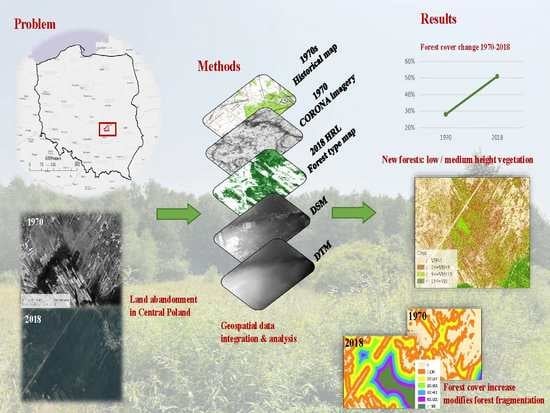The Substantial Increase of Forest Cover in Central Poland Following Extensive Land Abandonment: Szydłowiec County Case Study
Abstract
:1. Introduction
2. Materials and Methods
2.1. Study Area
2.2. Data
2.2.1. CORONA Imagery
2.2.2. Historical Topographic Map
2.2.3. Digital Elevation and Digital Surface Models
2.2.4. Copernicus High-Resolution Layers
2.3. Methods
2.3.1. Preparing Land Cover Layer for the 1970
2.3.2. Preparing Land Cover Layer for 2018 and Change Analysis
2.3.3. Assessing Vegetation Height for Land Cover Change Classes
2.3.4. Forest Pattern Change
3. Results
3.1. Forest Cover Change 1970–2018
3.2. Relation of Land Cover Change to Vegetation Height
3.3. Changes of Forest Pattern
4. Discussion
5. Conclusions
Author Contributions
Funding
Data Availability Statement
Acknowledgments
Conflicts of Interest
References
- Kuemmerle, T.; Kaplan, J.; Prishchepov, A.; Rylsky, I.; Chaskovskyy, O.; Tikunov, V.S.; Müller, D. Forest transitions in Eastern Europe and their effects on carbon budgets. Glob. Chang. Biol. 2015, 21, 3049–3061. [Google Scholar] [CrossRef] [PubMed]
- Khanal, N.R.; Watanabe, T. Abandonment of agricultural land and its consequences. Mt. Res. Dev. 2006, 26, 32–40. [Google Scholar] [CrossRef] [Green Version]
- Feranec, J.; Jaffrain, G.; Soukup, T.; Hazeu, G. Determining changes and flows in European landscapes 1990–2000 using CORINE land cover data. Appl. Geogr. 2010, 30, 19–35. [Google Scholar] [CrossRef]
- Li, S.; Li, X. Global understanding of farmland abandonment: A review and prospects. J. Geogr. Sci. 2017, 27, 1123–1150. [Google Scholar] [CrossRef]
- Baumann, M.; Kuemmerle, T.; Elbakidze, M.; Ozdogan, M.; Radeloff, V.C.; Keuler, N.S.; Prishchepov, A.V.; Kruhlov, I.; Hostert, P. Patterns and drivers of post-socialist farmland abandonment in Western Ukraine. Land Use Policy 2011, 28, 552–562. [Google Scholar] [CrossRef]
- Kolecka, N. Greening trends and their relationship with agricultural land abandonment across Poland. Remote Sens. Environ. 2021, 257, 112340. [Google Scholar] [CrossRef]
- Ortyl, B.; Kasprzyk, I. Land abandonment and restoration in the Polish Carpathians after accession to the European Union. Environ. Sci. Policy 2022, 132, 160–170. [Google Scholar] [CrossRef]
- Verburg, P.H.; Schulp, C.; Witte, N.; Veldkamp, A. Downscaling of land use change scenarios to assess the dynamics of European landscapes. Agric. Ecosyst. Environ. 2006, 114, 39–56. [Google Scholar] [CrossRef]
- Castillo, C.P.; Aliaga, E.C.; Lavalle, C.; Llario, J.C.M. An assessment and spatial modelling of agricultural land abandonment in Spain (2015–2030). Sustainability 2020, 12, 560. [Google Scholar]
- Levers, C.; Schneider, M.; Prishchepov, A.V.; Estel, S.; Kuemmerle, T. Spatial variation in determinants of agricultural land abandonment in Europe. Sci. Total Environ. 2018, 644, 95–111. [Google Scholar] [CrossRef]
- Van der Zanden, E.H.; Carvalho-Ribeiro, S.M.; Verburg, P.H. Abandonment landscapes: User attitudes, alternative futures and land management in Castro Laboreiro, Portugal. Reg. Environ. Change 2018, 18, 1509–1520. [Google Scholar] [CrossRef] [Green Version]
- Kolecka, N.; Kozak, J. Wall-to-wall parcel-level mapping of agricultural land abandonment in the Polish Carpathians. Land 2019, 8, 129. [Google Scholar] [CrossRef] [Green Version]
- Helming, K.; Pérez-Soba, M.; Tabbush, P. Sustainability Impact Assessment of Land Use Changes; Springer: Berlin/Heidelberg, Germany, 2008. [Google Scholar]
- Tasser, E.; Mader, M.; Tappeiner, U. Effects of land use in alpine grasslands on the probability of landslides. Basic Appl. Ecol. 2003, 4, 271–280. [Google Scholar] [CrossRef]
- Pazur, R.; Prishchepov, A.V.; Myachina, K.; Verburg, P.H.; Levykin, S.; Ponkina, E.V.; Kazachkov, G.; Yakovlev, I.; Akhmetov, R.; Rogova, N.; et al. Restoring steppe landscapes: Patterns, drivers and implications in Russia’s steppes. Landsc. Ecol. 2021, 36, 407–425. [Google Scholar] [CrossRef]
- Laiolo, P.; Dondero, F.; Ciliento, E.; Rolando, A. Consequences of pastoral abandonment for the structure and diversity of the alpine avifauna. J. Appl. Ecol. 2004, 41, 294–304. [Google Scholar] [CrossRef]
- Löw, F.; Fliemann, E.; Abdullaev, I.; Conrad, C.; Lamers, J.P. Mapping abandoned agricultural land in Kyzyl-Orda, Kazakhstan using satellite remote sensing. Appl. Geogr. 2015, 62, 377–390. [Google Scholar] [CrossRef]
- Szostak, M.; Wezyk, P.; Tompalski, P. Aerial orthophoto and airborne laser scanning as monitoring tools for land cover dynamics: A case study from the Milicz Forest District (Poland). Pure Appl. Geophys. 2014, 171, 857–866. [Google Scholar] [CrossRef] [Green Version]
- Zgłobicki, W.; Gawrysiak, L.; Baran-Zgłobicka, B.; Telecka, M. Long-term forest cover changes, within an agricultural region, in relation to environmental variables, Lubelskie province, Eastern Poland. Environ. Earth Sci. 2016, 75, 1373. [Google Scholar] [CrossRef] [Green Version]
- Kaim, D.; Kozak, J.; Kolecka, N.; Ziółkowska, E.; Ostafin, K.; Ostapowicz, K.; Gimmi, U.; Munteanu, C.; Radeloff, V.C. Broad scale forest cover reconstruction from historical topographic maps. Appl. Geogr. 2016, 67, 39–48. [Google Scholar] [CrossRef]
- Lieskovský, J.; Lieskovská, D. Cropland Abandonment in Slovakia: Analysis and Comparison of Different Data Sources. Land 2021, 10, 334. [Google Scholar] [CrossRef]
- Estacio, I.; Basu, M.; Sianipar, C.P.; Onitsuka, K.; Hoshino, S. Dynamics of land cover transitions and agricultural abandonment in a mountainous agricultural landscape: Case of Ifugao rice terraces, Philippines. Landsc. Urban Plan. 2022, 222, 104394. [Google Scholar] [CrossRef]
- Bezáková, M.; Bezák, P. Which sustainability objectives are difficult to achieve? The mid-term evaluation of predicted scenarios in remote mountain agricultural landscapes in Slovakia. Land Use Policy 2022, 115, 106020. [Google Scholar] [CrossRef]
- Kolecka, N.; Kozak, J.; Kaim, D.; Dobosz, M.; Ostafin, K.; Ostapowicz, K.; Price, B. Understanding farmland aban-donment in the Polish Carpathians. Appl. Geogr. 2017, 88, 62–72. [Google Scholar] [CrossRef]
- Bański, J. Gospodarka Ziemią w Polsce w Okresie Restrukturyzacji; Polska Akademia Nauk, Instytut Geografii i Przestrzennego Zagospodarowania im, Stanisława Leszczyckiego PAN: Warszawa, Poland, 1998. [Google Scholar]
- Bański, J. Changes in agricultural land ownership in Poland in the period of the market economy. Agric. Econ. 2011, 57, 93–101. [Google Scholar] [CrossRef] [Green Version]
- Janus, J.; Bożek, P.; Taszakowski, J.; Doroż, A. Decaying villages in the centre of Europe with no population decline: Long-term analysis using historical aerial images and remote sensing data. Habitat Int. 2022, 121, 102520. [Google Scholar] [CrossRef]
- GUS—Bank Danych Lokalnych, Bdl.stat.gov.pl. 2022. Available online: https://bdl.stat.gov.pl/ (accessed on 27 June 2022).
- Czapiewski, K.; Banski, J.; Górczynska, M. The impact of location on the role of small towns in regional development: Mazovia, Poland. Eur. Countrys. 2016, 8, 413. [Google Scholar] [CrossRef] [Green Version]
- Rymuza, K.; Bombik, A. Multidimensional analysis of social and economic development of some counties in Mazovia Voivodeship. Acta Sci. Polonorum. Oeconomia 2014, 13, 81–93. [Google Scholar]
- Ghuffar, S.; Bolch, T.; Rupnik, E.; Bhattacharya, A. A pipeline for AUTOMATED processing of Corona KH-4 (1962–1972) stereo imagery. arXiv 2022, arXiv:220107756. [Google Scholar]
- Challis, K.; Priestnall, G.; Gardner, A.; Henderson, J.; O’Hara, S. Corona remotely-sensed imagery in dryland archaeology: The Islamic city of al-Raqqa, Syria. J. Field Archaeol. 2004, 29, 139–153. [Google Scholar] [CrossRef]
- The CORONA Program. Web Page: National Reconnaissance Office Above and Beyond. Available online: https://www.nro.gov/History-and-Studies/Center-for-the-Study-of-National-Reconnaissance/The-CORONA-Program/ (accessed on 27 June 2022).
- Fekete, A. CORONA high-resolution satellite and aerial imagery for change detection assessment of natural hazard risk and urban growth in El Alto/La Paz in Bolivia, Santiago de Chile, Yungay in Peru, Qazvin in Iran, and Mount St. Helens in the USA. Remote Sens. 2020, 12, 3246. [Google Scholar] [CrossRef]
- Ostafin, K.; Iwanowski, M.; Kozak, J.; Cacko, A.; Gimmi, U.; Kaim, D.; Psomas, A.; Ginzler, C.; Ostapowicz, K. Forest cover mask from historical topographic maps based on image processing. Geosci. Data J. 2017, 4, 29–39. [Google Scholar] [CrossRef] [Green Version]
- Zhang, X.; Meng, X.; Li, C.; Shang, N.; Wang, J.; Xu, Y.; Wu, T.; Mugnier, C. Micro-Topography Mapping through Terrestrial LiDAR in Densely Vegetated Coastal Environments. ISPRS Int. J. Geo-Inf. 2021, 10, 665. [Google Scholar] [CrossRef]
- Leigh, C.L.; Kidner, D.B.; Thomas, M.C. The use of LiDAR in digital surface modelling: Issues and errors. Trans. GIS 2009, 13, 345–361. [Google Scholar] [CrossRef]
- Grudzień, M. “Geoportal.gov.pl”, Mapy.geoportal.gov.pl. 2022. Available online: https://mapy.geoportal.gov.pl/ (accessed on 27 June 2022).
- Malinowski, R.; Lewiński, S.; Rybicki, M.; Gromny, E.; Jenerowicz, M.; Krupiński, M.; Nowakowski, A.; Wojtkowski, C.; Krupiński, M.; Krätzschmar, E.; et al. Automated production of a land cover/use map of Europe based on Sentinel-2 imagery. Remote Sens. 2020, 12, 3523. [Google Scholar] [CrossRef]
- Copernicus Program. 2022. Available online: https://land.copernicus.eu/pan-european/high-resolution-layers/forests/forest-type-1/status-maps/forest-type-2018?tab=metadata (accessed on 27 June 2022).
- Copernicus Program User Manual. Available online: https://land.copernicus.eu/user-corner/technical-library/forest-2018-user-manual.pdf (accessed on 27 June 2022).
- Główny Urząd Geodezji i Kartografii. Instrukcja Techniczna K-2—Mapy Topograficzne do Celów Gospodarczych, 2nd ed.; Główny Urząd Geodezji i Kartografii: Warszawa, Poland, 1980.
- Vogt, P.; Riitters, K.H.; Estreguil, C.; Kozak, J.; Wade, T.G.; Wickham, J.D. Mapping spatial patterns with morphological image processing. Landsc. Ecol. 2007, 22, 171–177. [Google Scholar] [CrossRef]
- Zgłobicki, W.; Karczmarczuk, K.; Baran-Zgłobicka, B. Intensity and driving forces of land abandonment in Eastern Poland. Appl. Sci. 2020, 10, 3500. [Google Scholar] [CrossRef]
- Hościło, A.; Mirończuk, A.; Lewandowska, A. Determination of the actual forest area in Poland based on the available spatial datasets. Sylwan 2016, 160, 627–634. [Google Scholar]
- Janus, J.; Bozek, P. Land abandonment in Poland after the collapse of socialism: Over a quarter of a century of increasing tree cover on agricultural land. Ecol. Eng. 2019, 138, 106–117. [Google Scholar] [CrossRef]
- Budniak, P.; Zięba, S. Effects of Forest Fragmentation on the Volume of Wood Resources in Managed, Pine-Dominated Forests in Poland. Forests 2022, 13, 590. [Google Scholar] [CrossRef]
- Meyer, S.T.; Heuss, L.; Feldhaar, H.; Weisser, W.W.; Gossner, M.M. Land-use components, abundance of predatory arthropods, and vegetation height affect predation rates in grasslands. Agric. Ecosyst. Env. Ment 2019, 270, 84–92. [Google Scholar] [CrossRef]
- Biró, M.; Molnár, Z.; Öllerer, K.; Demeter, L.; Bölöni, J. Behind the general pattern of forest loss and gain: A long-term assessment of semi-natural and secondary forest cover change at country level. Landsc. Urban Plan. 2022, 220, 104334. [Google Scholar] [CrossRef]
- Batáry, P.; Fronczek, S.; Normann, C.; Scherber, C.; Tscharntke, T. How do edge effect and tree species diversity change bird diversity and avian nest survival in Germany’s largest deciduous forest? For. Ecol. Manag. 2014, 319, 44–50. [Google Scholar] [CrossRef]
- Fornal-Pieniak, B.; Łowicki, D.; Schwerk, A.; Li, J. Where is the forest core area? Gradients of flora in the ecotone of urban forests in Warsaw. Landsc. Urban Plan. 2022, 224, 104427. [Google Scholar] [CrossRef]
- Proesmans, W.; Bonte, D.; Smagghe, G.; Meeus, I.; Decocq, G.; Spicher, F.; Kolb, A.; Lemke, I.; Diekmann, M.; Bruun, H.H.; et al. Small forest patches as pollinator habitat: Oases in an agricultural desert? Landsc. Ecol. 2019, 34, 487–501. [Google Scholar] [CrossRef] [Green Version]
- Bojarska, K.; Maugeri, L.; Kuehn, R.; Król, W.; Theuerkauf, J.; Okarma, H.; Gula, R. Wolves under cover: The importance of human-related factors in resting site selection in a commercial forest. For. Ecol. Manag. 2021, 497, 119511. [Google Scholar] [CrossRef]
- Leal Filho, W.; Mandel, M.; Al-Amin, A.Q.; Feher, A.; Chiappetta Jabbour, C.J. An assessment of the causes and consequences of agricultural land abandonment in Europe. Int. J. Sustain. Dev. World Ecol. 2017, 24, 554–560. [Google Scholar] [CrossRef] [Green Version]
- Rendenieks, Z.; Nita, M.D.; Nikodemus, O.; Radeloff, V.C. Half a century of forest cover change along the Latvian-Russian border captured by object-based image analysis of Corona and Landsat TM/OLI data. Remote Sens. Environ. 2020, 249, 112010. [Google Scholar] [CrossRef]
- Jabs-Sobocińska, Z.; Affek, A.N.; Ewiak, I.; Nita, M.D. Mapping mature post-agricultural forests in the Polish eastern Carpathians with archival remote sensing data. Remote Sens. 2021, 13, 2018. [Google Scholar] [CrossRef]
- Watanabe, N.; Nakamura, S.; Liu, B.; Wang, N. Utilization of Structure from Motion for processing CORONA satellite images: Application to mapping and interpretation of archaeological features in Liangzhu Culture, China. Archaeol. Res. Asia 2017, 11, 38–50. [Google Scholar] [CrossRef]
- Congedo, L.; Sallustio, L.; Munafò, M.; Ottaviano, M.; Tonti, D.; Marchetti, M. Copernicus high-resolution layers for land cover classification in Italy. J. Maps 2016, 12, 1195–1205. [Google Scholar] [CrossRef] [Green Version]
- Fischer, R.; Taubert, F.; Müller, M.S.; Groeneveld, J.; Lehmann, S.; Wiegand, T.; Huth, A. Accelerated forest fragmentation leads to critical increase in tropical forest edge area. Sci. Adv. 2021, 7, eabg7012. [Google Scholar] [CrossRef] [PubMed]
- Cimatti, M.; Ranc, N.; Benítez-López, A.; Maiorano, L.; Boitani, L.; Cagnacci, F.; Čengić, M.; Ciucci, P.; Huijbregts, M.A.J.; Krofel, M.; et al. Large carnivore expansion in Europe is associated with human population density and land cover changes. Divers. Distrib. 2021, 27, 602–617. [Google Scholar] [CrossRef]
- Hu, X.; Huang, B.; Verones, F.; Cavalett, O.; Cherubini, F. Overview of recent land-cover changes in biodiversity hotspots. Front. Ecol. Environ. 2021, 19, 91–97. [Google Scholar] [CrossRef]
- Saleem, A.; Corner, R.; Awange, J. On the possibility of using CORONA and Landsat data for evaluating and mapping long-term LULC: Case study of Iraqi Kurdistan. Appl. Geogr. 2018, 90, 145–154. [Google Scholar] [CrossRef]

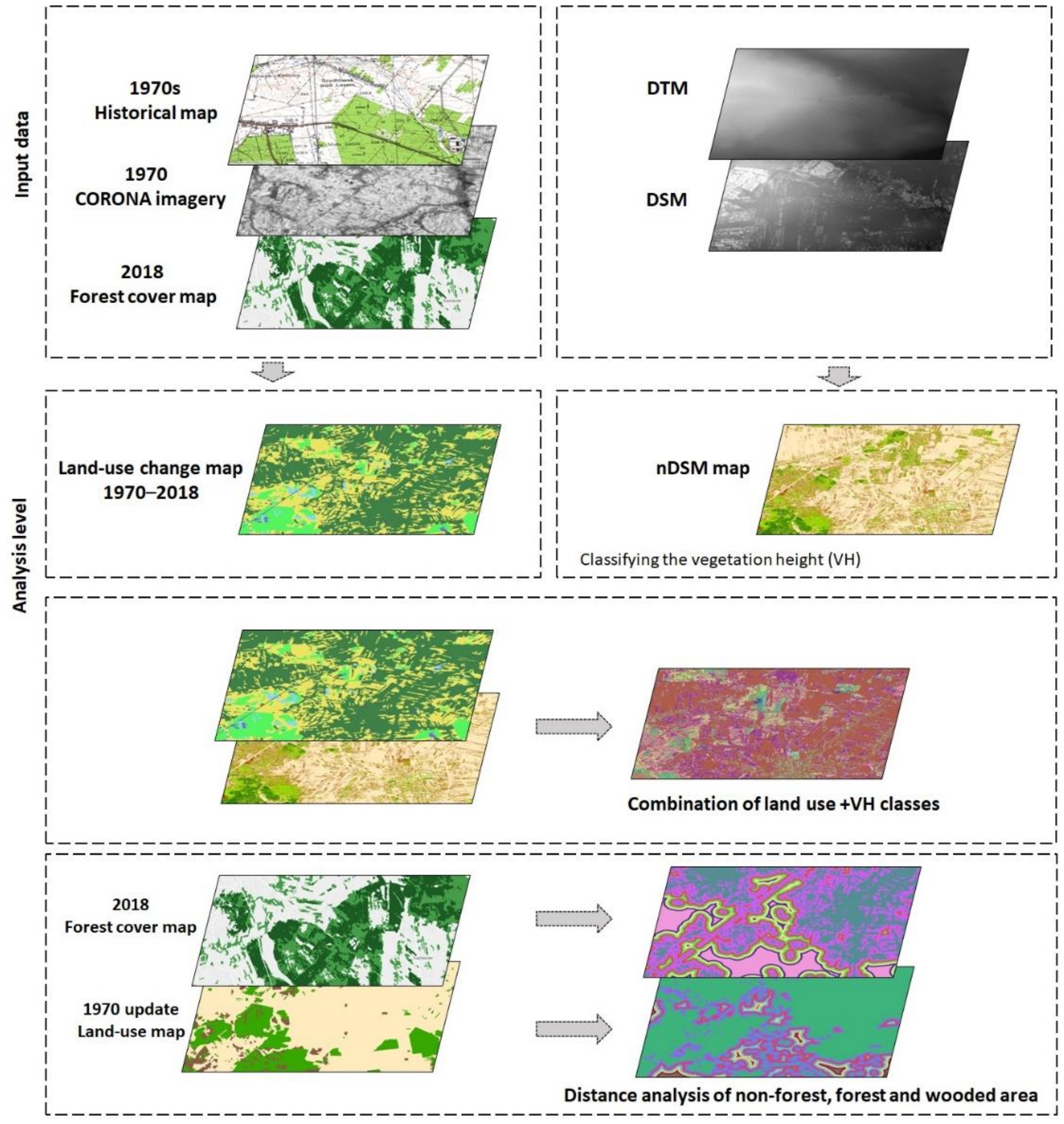

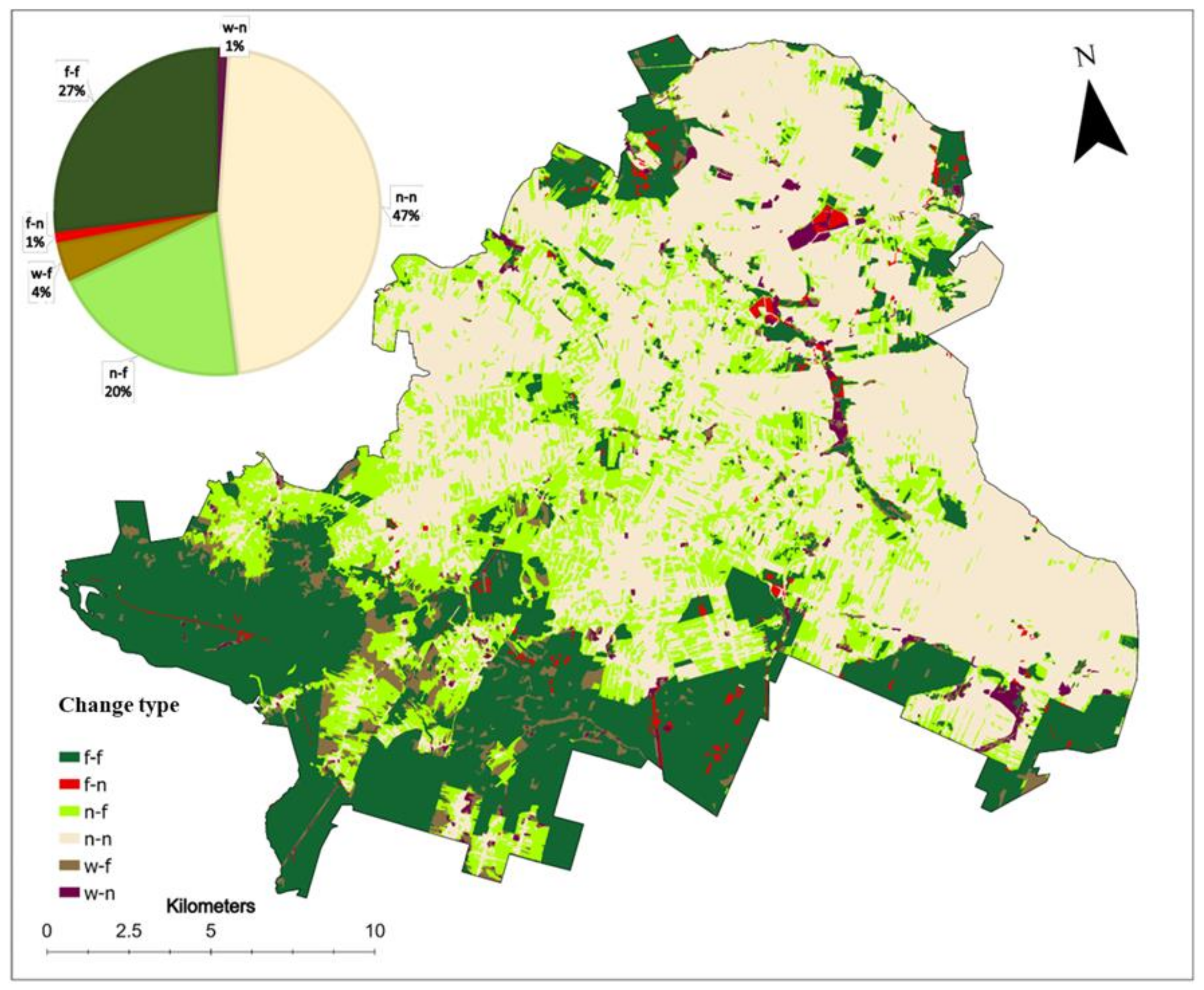
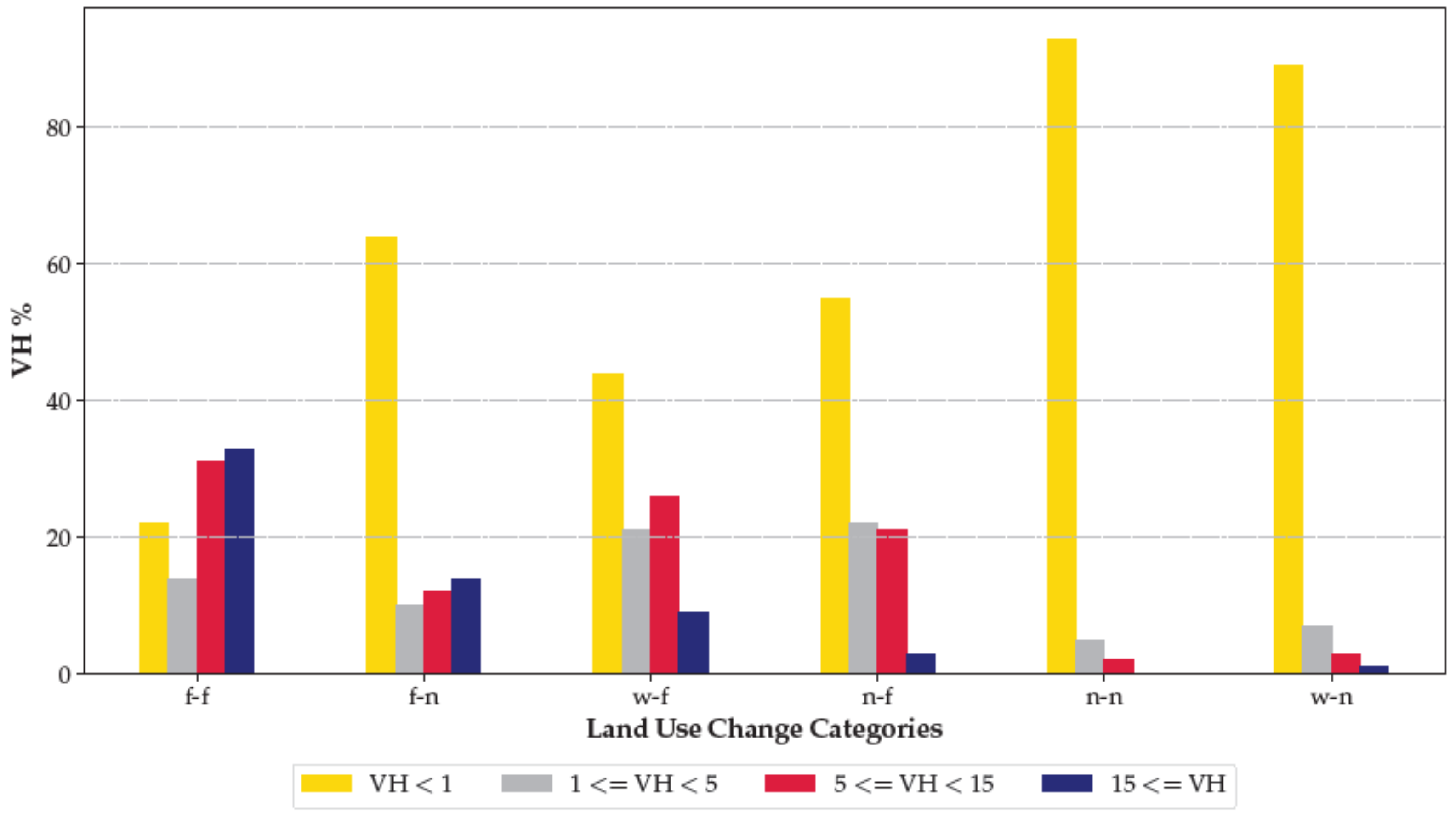

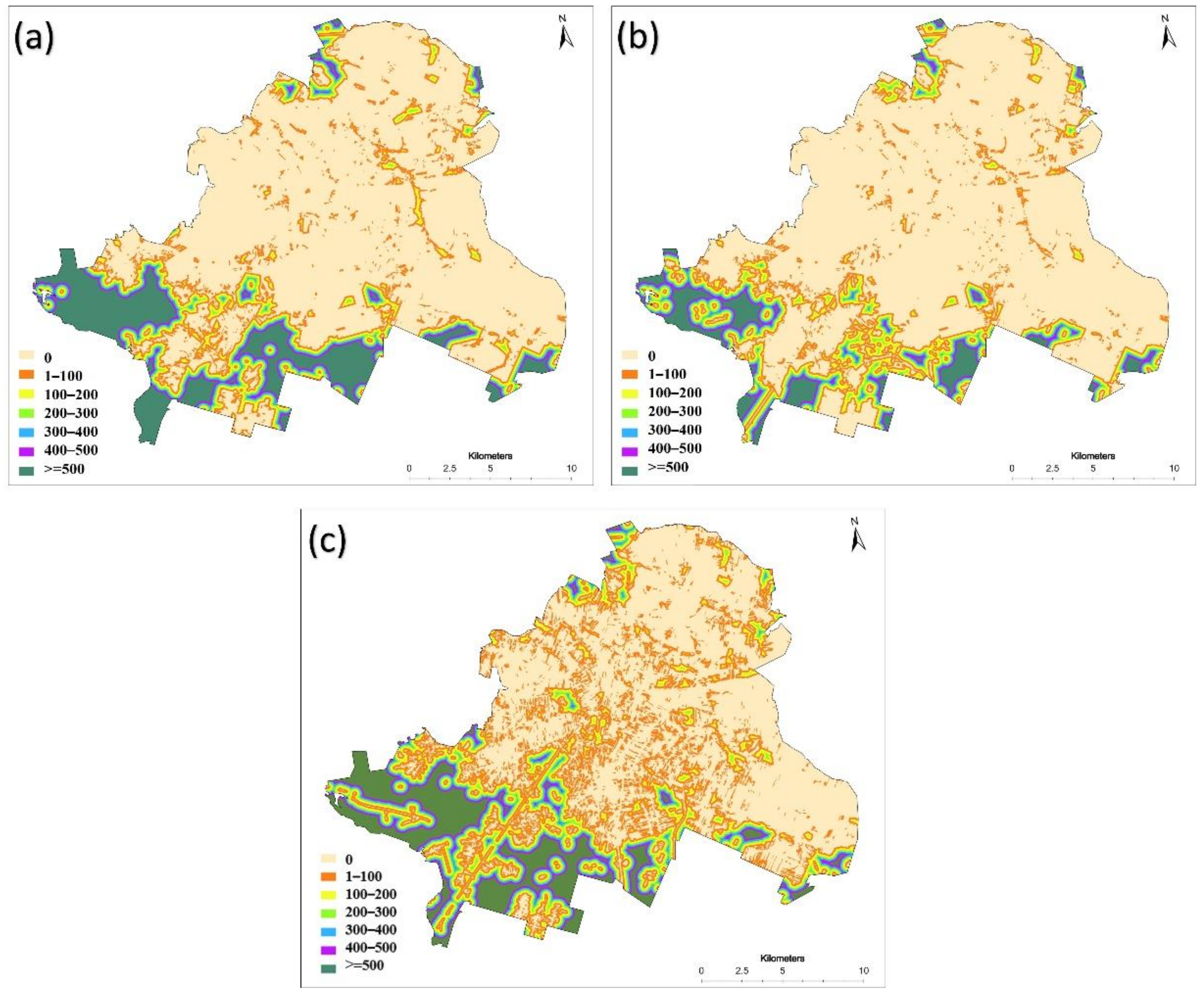
Publisher’s Note: MDPI stays neutral with regard to jurisdictional claims in published maps and institutional affiliations. |
© 2022 by the authors. Licensee MDPI, Basel, Switzerland. This article is an open access article distributed under the terms and conditions of the Creative Commons Attribution (CC BY) license (https://creativecommons.org/licenses/by/4.0/).
Share and Cite
Shahbandeh, M.; Kaim, D.; Kozak, J. The Substantial Increase of Forest Cover in Central Poland Following Extensive Land Abandonment: Szydłowiec County Case Study. Remote Sens. 2022, 14, 3852. https://doi.org/10.3390/rs14163852
Shahbandeh M, Kaim D, Kozak J. The Substantial Increase of Forest Cover in Central Poland Following Extensive Land Abandonment: Szydłowiec County Case Study. Remote Sensing. 2022; 14(16):3852. https://doi.org/10.3390/rs14163852
Chicago/Turabian StyleShahbandeh, Mahsa, Dominik Kaim, and Jacek Kozak. 2022. "The Substantial Increase of Forest Cover in Central Poland Following Extensive Land Abandonment: Szydłowiec County Case Study" Remote Sensing 14, no. 16: 3852. https://doi.org/10.3390/rs14163852
APA StyleShahbandeh, M., Kaim, D., & Kozak, J. (2022). The Substantial Increase of Forest Cover in Central Poland Following Extensive Land Abandonment: Szydłowiec County Case Study. Remote Sensing, 14(16), 3852. https://doi.org/10.3390/rs14163852






